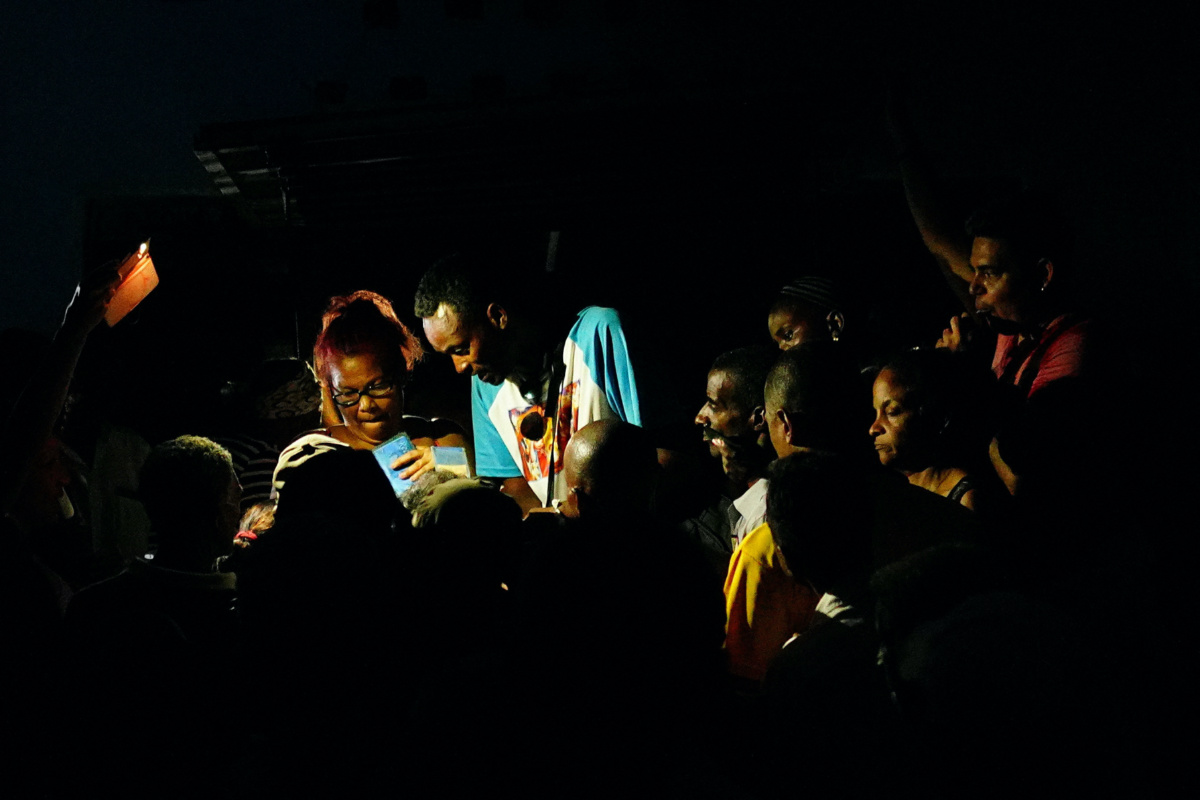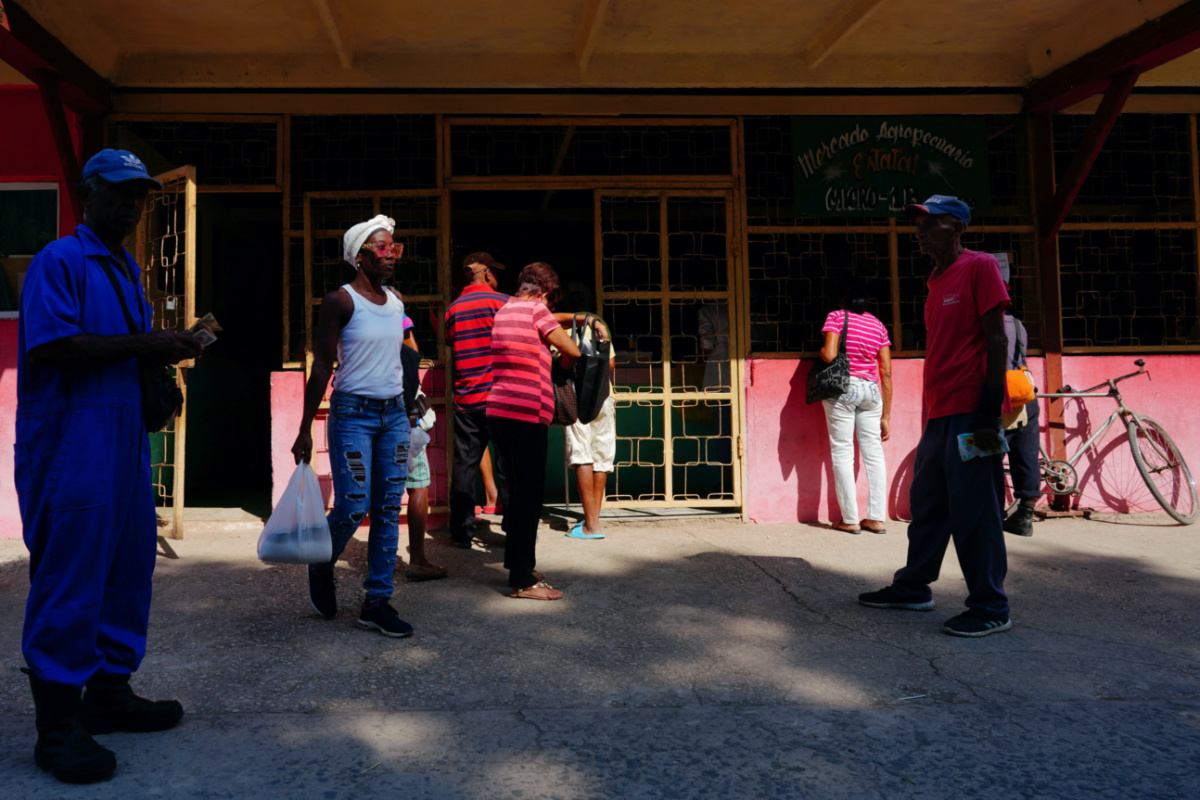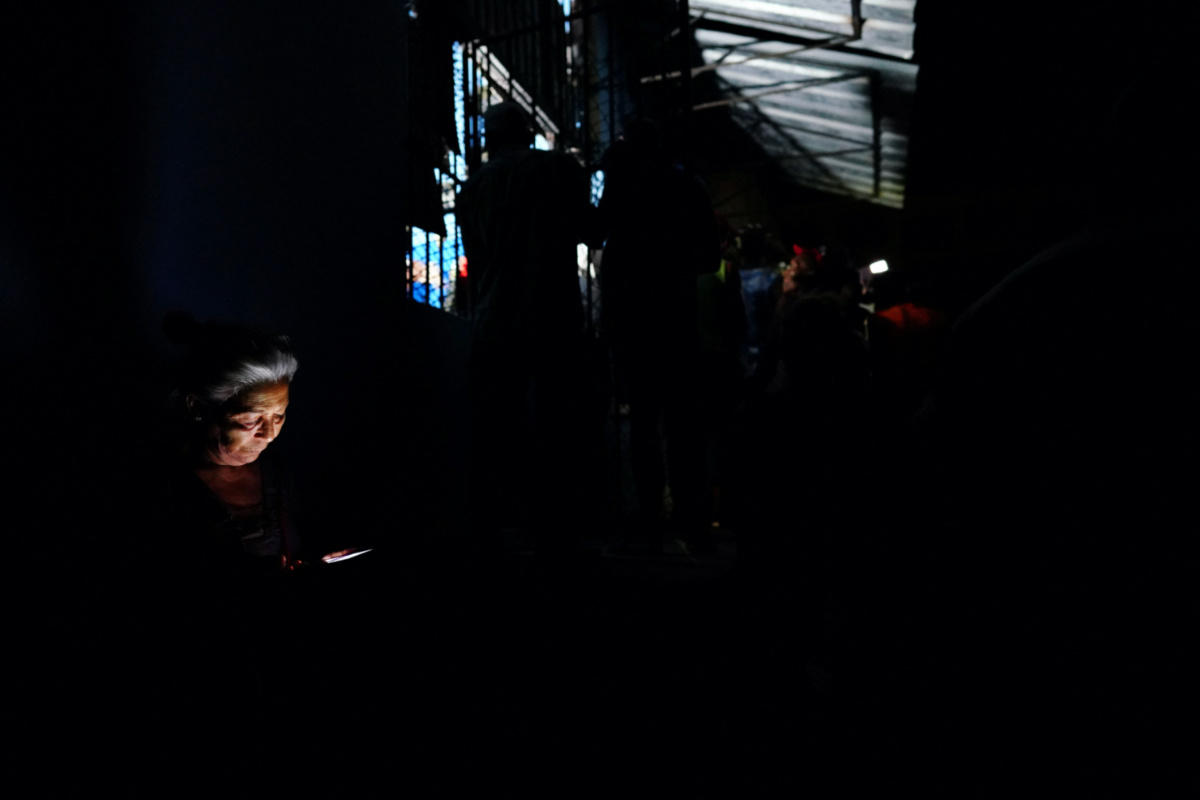
DAVE SHERWOOD and ALIEN FERNANDEZ, of Reuters, report from Santiago de Cuba…
Santiago de Cuba
Reuters
A crowd swarms the steps of a small state-run market on the outskirts of Santiago, Cuba‘s second-largest city, sweating and shouting, jostling for a chance at a once-monthly ration of chicken.
A pound bag of thighs is going for a bargain 20 pesos – about a nickel at the black-market exchange rate – but furor devolves to chaos as word spreads there may not be enough for everyone.
And that’s when the lights go out.
“This is life here,” said Mauri Macias, a 39-year-old chef with two children who spoke with Reuters as he waited his turn to buy a handful of the government-subsidised poultry. “You live without being able to make plans.”

People try to get a once-monthly ration of chicken, during a blackout, at a small state-run market in Santiago, Cuba, on 20th March, 2024. PICTURE: Reuters/Alexandre Meneghini/File photo
The episode on a recent Wednesday in Santiago – the site earlier this month of a rare public protest – provides a telling snapshot of the challenge facing Cuba‘s government: When the power fails, tensions – even in areas sympathetic to Fidel Castro’s 1959 communist Revolution – begin to soar.
Reuters interviewed more than two dozen residents and local officials in the Santiago de Cuba neighbourhoods of Veguita del Galo, Jose Marti, Micro 9 and Abel Santamaria. They told of their frustration at food shortages and electricity outages that sometimes top 10 hours daily.
“Living without electricity is primitive. The mosquitoes, the heat, sometimes there is no water. People are losing their minds. And that leads to other problems, like violence.”
– Yoni Mena, a 34-year-old who runs a vegetable stand in Abel Santamaria, a hillside neighbourhood.
“Living without electricity is primitive,” said Yoni Mena, a 34-year-old who runs a vegetable stand in Abel Santamaria, a hillside neighborhood.
“The mosquitoes, the heat, sometimes there is no water. People are losing their minds. And that leads to other problems, like violence.”
Several hundred protesters gathered on 17th March in Santiago’s Carretera del Morro Park, chanting “power and food,” according to first-hand accounts from local residents. Social media videos showed a smaller group shouting “freedom” as local Communist Party leader Beatriz Johnson prepared to speak with the crowd from a rooftop.
Both the government and observers characterized the protests as largely peaceful.
The Cuban Government, once reticent to acknowledge protests, now calls for dialogue and has moved quickly to attend to grievances in areas where they have flared.

People line up in a market in Santiago, Cuba, on 20th March, 2024. REUTERS/Alexandre Meneghini/File Photo
In Santiago de Cuba, local officials and residents said the government has begun to distribute subsidised rations, including chicken, rice, sugar and milk.
Power supply also became much more regular in the week following the protests, according to residents and Reuters observations.
“We are aware that [lack of] electricity provides the spark for any protest,” Energy and Mining Minister Vicente de la O’Levy said last week.
Cuban President Miguel Diaz-Canel blames the United States and the “capitalist media” for stoking protests, and says his government is willing to have dialogue with upset citizens.
Reuters, which did not witness a protest while in Santiago in the days following the 17th March rallies, requested an interview with Communist Party officials to discuss the earlier demonstrations but received no response.
Santiago, a Caribbean outpost some 870 kilometres south and east of the capital Havana by rutted roads, dubs itself the “cradle” of the Cuban Revolution.
The former Moncada military barracks downtown were the site of the revolution’s first battle in 1953. Castro himself, who ruled the island for nearly five decades, once lived in a wooden home overlooking the bay. He is buried here, his tombstone marked simply “Fidel.”
The city, like Cuba, has fallen on hard times since the COVID-19 pandemic. Tourism – once a major source of foreign currency – has sputtered, with potential visitors put off by a lack of infrastructure, US visa rules and news coverage of economic woes and unrest.
A long-standing US trade embargo and related sanctions, as well as an inefficient state-run economy, have led to shortages of food, fuel and medicine, while Cuba‘s obsolete power plants cannot meet demand.

An elderly woman uses a mobile phone as she waits to get a once-monthly ration of chicken, during a blackout, at a small state-run market in Santiago, Cuba, on 20th March, 2024. PICTURE: Reuters/Alexandre Meneghini/File photo
Mirta Rusel, 58, a state textile worker in Jose Marti, earns 3,410 pesos ($US10) a month. She said she had adapted to the power outages, but not to food shortages.
“In the days there was no rice, I ate only sweet potato,” said Rusel, adding that recently she would fry it in oil for variety. “That’s the reality of life in Cuba.”
Some Cubans Reuters spoke to in Santiago talked of their appreciation for a system that for decades provided basic state-subsidized healthcare, food, housing and education.
Luz Perez, 48, a former schoolteacher who lives in an apartment block built by the Castro administration, said she would not protest but felt authorities needed to take action.
“Aggression doesn’t solve anything,” Perez said. “I love Cuba. But this situation is terrible. No one can live like this.”
We rely on our readers to fund Sight's work - become a financial supporter today!
For more information, head to our Subscriber's page.
Cuba‘s 2019 constitution grants citizens the right to protest, but a law more specifically defining that right is stalled in the legislature, leaving those who take to the street in legal limbo.
Others try to work with the system.
Maria Antonia Figuera, a neighbourhood block leader who represents 1,500 people in Abel Santamaria, said she attends often angry complaints day and night.
Figuera said she organises sporting events for children during blackouts and is constantly wrangling with local officials to assure water and food.
“People are irritated,” she said in an interview at her home. “We have to solve our own problems here, because no one is going to do it for us.”

Neighbourhood block leader Maria Antonia Figuera speaks during an interview at her home in Santiago, Cuba, on 21st March, 2024. PICTURE: Reuters/Alexandre Meneghini/File photo
Rights groups, the European Union and the United States say Cuba‘s heavy-handed response to anti-government rallies on 11th July, 2021 – the largest in decades – have also led many to think twice before attending demonstrations.
In the wake of the 17th March protests, 38 people were arrested countrywide, including several in Santiago, according to Spain-based Prisoners Defenders. Cuban authorities have said some protesters committed crimes ranging from public disobedience to vandalism, but have not provided information on detentions.
A government truck carrying “black beret” Interior Ministry troops – sometimes employed to disperse protesters – was parked on Wednesday and Thursday night at the site of the largest March 17 protest, near a local Communist Party headquarters in Veguita del Galo.
Maria Elena Casanova, a 64-year old state worker who lives near the site of the Santiago protest and watched it take place, described it as peaceful – and the natural conclusion of several weeks without power.
“I don’t feel that anyone planned it,” she said as she sat on her doorstep waiting for power to return to the neighbourhood.
“That was the people there, expressing their problems.”
– Additional reporting by ALEXANDRE MENEGHINI






